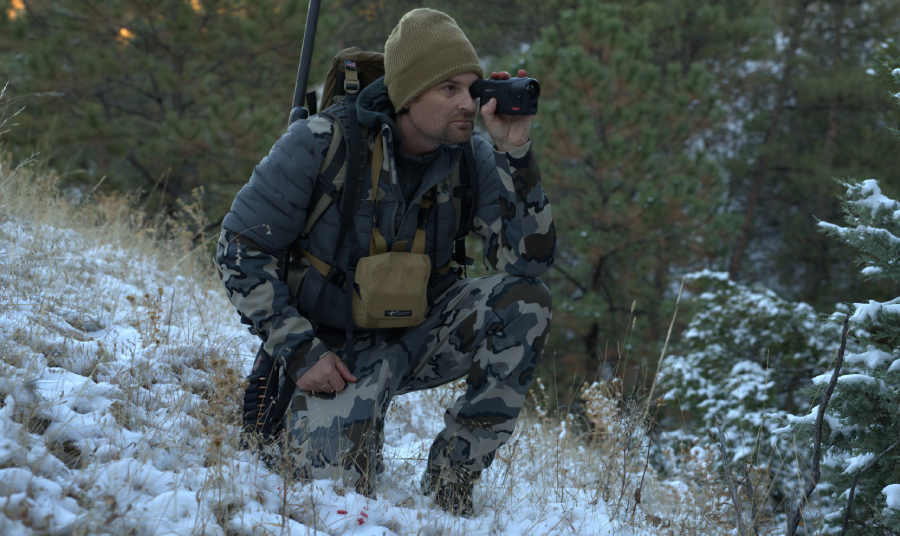Thermal optics have become a go-to tool for hunters who want to track game more efficiently after dark. Animals like hogs, coyotes, and raccoons are most active when visibility is at its worst, which leaves traditional glass optics or spotlights struggling to keep up. A thermal monocular changes that equation, and the Pulsar Oryx LRF XG35 is one of the most practical options available today.
With its 1,800-meter detection range, integrated laser rangefinder, and rugged magnesium housing, the Oryx gives hunters the ability to scan, plan, and confirm targets in conditions where guessing used to be the norm. Instead of stumbling into a group of hogs, losing track of a cautious coyote, or shining a light that spooks raccoons, hunters can quietly monitor movement and make smarter decisions.
Hogs

Wild hogs are unpredictable, destructive, and often travel in groups. For hunters, that means more targets but also more opportunities to get busted if you approach carelessly. The Pulsar Oryx LRF XG35 thermal monocular is particularly effective here because of its long detection range and wide field of view. You can spot entire sounders across open fields before they have any idea you’re around.
A good tactic is to use the Oryx to map hog movement at a distance. The 1,800-meter detection range lets you watch how a sounder works a crop field or treeline, then use the laser rangefinder to plan a stalk. Knowing exact distances is critical—closing the gap too quickly can alert them, while waiting too long gives them a chance to move off. With hogs, the Oryx is most valuable as an early-warning system, letting you cut them off instead of chasing them.
Another advantage is heat differentiation. In a group of ten hogs, you can tell the larger boars from the smaller shoats by comparing heat signatures. Bigger bodies hold heat differently, especially after dark, which helps you pick out the best target.
Coyotes

Coyotes are smarter and warier than hogs. They often respond to calls but circle downwind, testing for scent before committing. The Oryx gives hunters an edge here because you can detect them before they close in. When a coyote hangs back at 400 yards, the thermal monocular picks up its cautious movement in the brush—something night vision often misses.
Using the rangefinder, you can mark natural boundaries—fence lines, brush piles, or tree stands—so you’ll know the exact moment a coyote steps into shooting range. Coyotes tend to pause and scan before committing to a call. Having the Oryx ready during that pause gives you the chance to switch from observation to rifle scope without guessing at distance.
The Oryx also helps identify false alarms. A raccoon or stray dog moving through brush can look similar in poor light, but the Oryx’s resolution and stabilization help confirm whether you’re dealing with a predator or not, saving wasted shots and mistakes.
Raccoons

Raccoon hunting is a different game. They’re smaller, they climb, and they don’t always move in predictable patterns. Traditional lights can spook them, especially on pressured land. With the Pulsar Oryx LRF XG35, you can scan treelines and field edges without giving away your position. The compact size of the Oryx makes it easy to carry in one hand or hang on a lanyard, which is useful when you’re juggling a rifle, calls, and gear at night.
The key advantage is seeing raccoons before they see you. Thermal signatures pop against tree trunks, even when the animal is clinging to the side or moving through the canopy. Using the Oryx to sweep treelines gives you a clear idea of where they’re active, saving time and letting you focus on the best spots.
For hunters who run dogs, the Oryx is also helpful in keeping track of the action. You can monitor raccoon movement ahead of the chase, spot treed animals quickly, and keep better awareness of what’s happening in the woods around you.
Conclusion
The Pulsar Oryx LRF XG35 adapts to the species you’re after. Against hogs, it works as a long-range scout to cut off groups before they move. For coyotes, it gives early warning of cautious predators and confirms shooting distances. For raccoons, it allows you to sweep treelines silently and efficiently, spotting animals that would otherwise blend into the night.
Whatever the target, the Oryx’s combination of detection range, accurate rangefinding, and compact design makes it more than a tool for general scouting—it’s a game-specific advantage that shortens the gap between seeing heat and making a shot.
Frequently Asked Questions
What makes the Pulsar Oryx LRF XG35 effective for hog hunting?
The Oryx’s 1,800-meter detection range and wide field of view allow hunters to track entire sounders from a distance. Its laser rangefinder helps plan stalks precisely, while heat differentiation makes it easier to identify larger boars among smaller hogs.
How does the Oryx help when hunting coyotes?
Coyotes are cautious and often hang back, but the Oryx can detect them beyond 400 yards. With the integrated rangefinder, hunters can mark boundaries and know the exact distance when coyotes pause or scan, reducing guesswork and improving shot timing.
Can the Oryx distinguish between coyotes and other animals?
Yes. Its resolution and stabilization make it easier to confirm whether movement in the brush is a predator like a coyote or a false alarm such as a raccoon or stray dog, preventing wasted shots.
Why is the Oryx useful for raccoon hunting?
The Oryx lets hunters scan treelines and field edges silently without spooking raccoons. Thermal signatures stand out even when raccoons are climbing or clinging to trees, making it easier to locate them quickly.
Is the Oryx practical for hunters who use dogs?
Yes. The Oryx helps track raccoon movement ahead of a chase, spot treed animals, and maintain awareness of activity in the woods, which makes managing dogs and the hunt more efficient.




